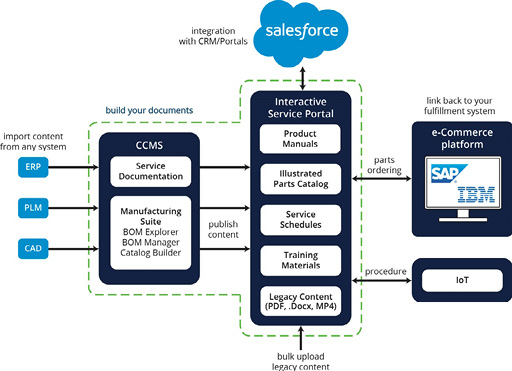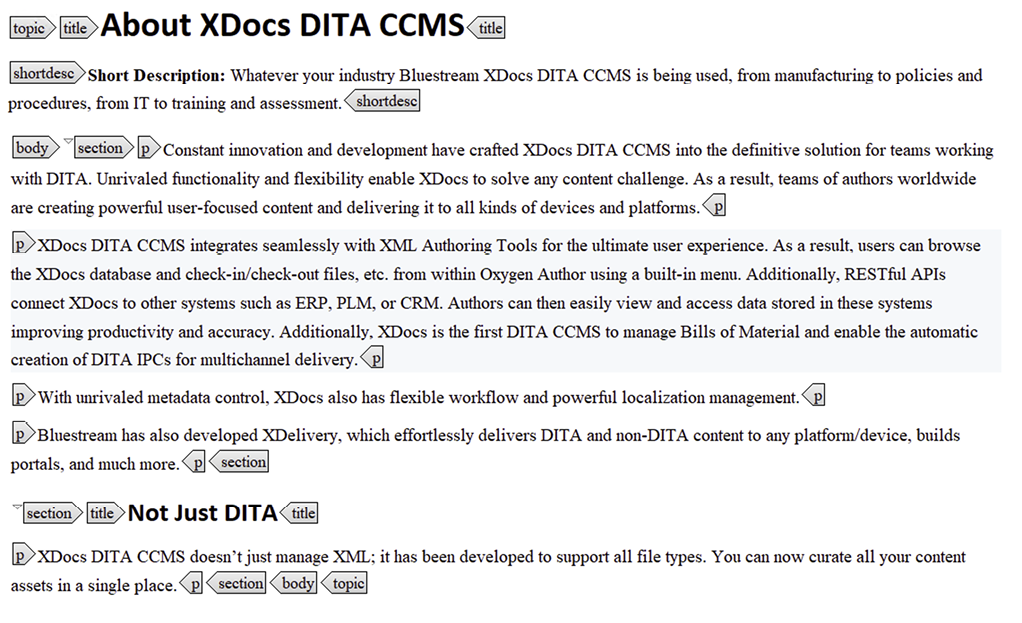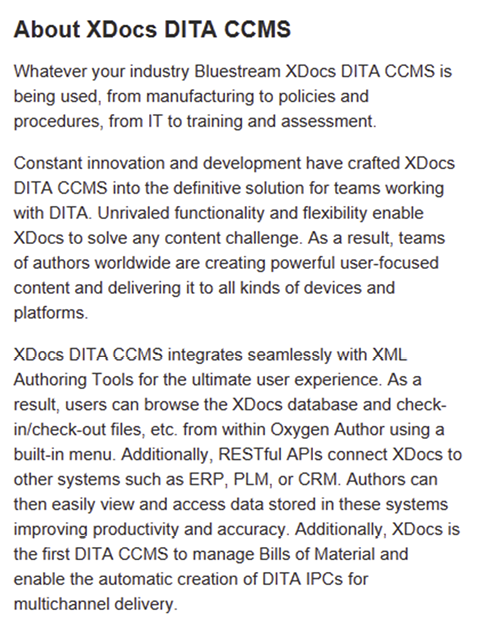By Jack Molisani | STC Fellow
Make the jump from traditional publishing to structured authoring, and from there to Content 4.0.
In an earlier article, Joe Gollner and I predicted how Content 3.0 would enable technical communicators to create content that is part of a greater content-based ecosystem. In this article, I predict that by integrating content into other enterprise systems (Content 4.0), you can save production costs and also transform documentation departments from cost centers to revenue-generating profit centers.
The Evolution of Content
Content 1.0 to 4.0 loosely parallels the four stages in the evolution of manufacturing, starting with the industrial revolution in the late 18th century:
Industry 1.0 The early days where mechanization was first applied to manufacturing. Industry 1.0 was the first industrial revolution, primarily kick-started by the evolution of the steam engine.
Industry 2.0 Driven by advances in communications and transportation. The telegraph provided a way to communicate information instantly over long distances, and the railways allowed large numbers of people to move from place to place taking their skills with them.
Industry 3.0 The introduction of systematic automation to the manufacturing process in the later 20th century. The third industrial revolution was driven by the advancement of electronics, computers, and the internet.
Industry 4.0 Highlights the most recent trends in advanced automation, where manufacturing lines communicate with other enterprise systems to optimize production. Increased computerization within manufacturing enabled interconnectivity, information transparency, decentralized decisions, and technical assistance.
The ways of creating and distributing content contains four similar phases of advancement:
Content 1.0 Refers to the way that content has been recorded prior to the printing press, from cave painting through books replicated by hand.
Content 2.0 Driven by the invention and development of the printing press with moveable type. This enabled multiple copies of a book to be recreated much faster than previous processes.
Content 3.0 The use of desktop publishing, the Internet, and other authoring systems enable organizations to publish information simultaneously to an almost unlimited number of readers.
Content 4.0 The evolution of content development and distribution makes a quantum leap forward. Not only can content be consumed on many types of devices (a laptop, a cell phone, etc.), content can also be displayed within other system interfaces—from car dashboards to nuclear reactor control systems!
Making the Leap to Structured Authoring
The most common way of publishing content today (desktop publishing) is fraught with challenges:
- Information is developed by various departments within an organization (tech pubs, training, marketing, and so on). Often each department uses different authoring tools and version control systems, creating “content silos.”
- When content changes are made, they must be made in multiple places. This introduces inconsistencies across content silos, which in turn, create an inconsistent information experience (not to mention safety and compliance risks in regulated industries).
- Consider how many of the above problems exist when documenting one product or product line. Now consider the complexities involved in documenting multiple product lines being translated into multiple languages, and the problem becomes almost impossible to manage using traditional tools like MS Word and SharePoint.
The solution? Author, store, and publish content from a single database known as a component content management system (CCMS). Creating content in such a database is called “structured authoring.” In structured authoring, formatting is not done when the content is created, it is formatted when it is published. The CCMS detects the type of devices on which the content is being consumed, and formats the content for the device being used: cell phone, laptops, kiosks, even jumbotrons!
Content 4.0
While Content 3.0 enables dynamic publishing, Content 4.0 enables content to be embedded or displayed in other system interfaces (as opposed to the reader having to look up the information in an external source, such a printed manual, a PDF on a laptop, or a web page on their phone).
For example, a nuclear power plant control system generates an alarm. Rather than the operator having to look in a job aid to see what to do in response, the control system automatically pulls the most recent version of the procedure from the CCMS and displays it in the control system console, right next to the alarm notification.
Generating Revenue
Perhaps a nuclear control system is not applicable to your organization. Let’s discuss a few that might be:
Consider connecting your CCMS to the systems the Sales and Marketing teams use to generate revenue. Systems such as:
- Customer Relationship Management (CRM)
- Proposal Management Systems (PMS)
- Enterprise Resource Planning (ERP)
- Product Lifecycle Management (PLM)
- Computer Aided Design (CAD)
- Illustrated Part Catalogs (IPCs), and more—

Examples
Suppose a consumer visits a web page on how to reset a helmet-mounted video camera. The page mentions the error is caused by too little memory in the camera, with a procedure for freeing up space. The same page also displays marketing info, saying upgrade to the latest camera model which has more memory. If the consumer logged in to the website (and the company has their email address), the CCMS that displayed both the tech content and the marketing content could send a message to the company’s automated marketing system, which in turn, emails the customer a coupon code to upgrade.
Granted, in the days of web cookies and traffic trackers, it is possible to be too helpful and intrusive. But the point is, by integrating your CCMS into other company systems, your department can help generate revenue for your company.
Here is a slightly more complex manufacturing example:
A manufacturing facility has assembly lines containing hundreds of machines and thousands of components, components that can break or need periodic replacement.
An operator monitors a manufacturing control system, and can alert a technician when something in the assembly line needs to be serviced.
When this happens, technicians replacing the affected parts and components often search for the replacement part using in an illustrated parts catalog, which may contain thousands of parts. They then order the parts in a separate purchasing system—only to discover when they arrive that a simple typo made them order the wrong parts!
Then the techs have to re-order the correct parts and wait for them to be delivered again. This costs companies millions in lost revenue.
On the other hand, what if the exact part needed was in a CCMS along with the repair procedure? And what if the manufacturing control system was connected to both the CCMS and to the part ordering system? The control system would identify the malfunctioning equipment and display the exact part(s) needed to repair it. All the technician would need to do is click the items to order them.
This not only eliminates the time needed to look up and order the correct part, but also the CCMS and the part ordering system could suggest other parts that might soon need to replaced, prompting the customer to purchase those parts as well.
Granted, someday AI (artificial intelligence) will probably identify the problem and order the replacement part without human intervention. Until then, documentation departments can save companies the lost revenue that results from human error—like technicians ordering wrong parts from an electronic parts catalog and a part ordering system that is not integrated with the company’s CCMS.
How could integrating a CCMS into other systems reduce costs or generate revenue in your organization?
The possibilities are endless!
Where to Start?
Making the jump from traditional publishing to structured authoring (and from there to Content 4.0) can be daunting. Where to start?
First, adopt the viewpoint that your content can be a source of revenue for your organization. Next, do a content inventory. Find out where content is stored, who owns it, where your organization can benefit from reuse. Then look at the entire customer journey, from pre-sales to installation to operations to support. Talk with your sales, marketing, and product development teams. Brainstorm how many ways your organization could generate additional revenue if content was integrated into other product interfaces. Then build a business case showing the return on investment (ROI) that will result from moving content into a CCMS and integrating the CCMS into other enterprise systems.
Note: If you’ve never written a business case, start by reading the Intercom article “How to Build a Business Case” by Jack Molisani and Bonni Graham.
Sources of Information
Where can you get numbers for your business case? Go to conferences like the STC Summit and ask other members how they adopted structured authoring, search content strategy-related groups on LinkedIn and other platforms for information and webinars, ask CCMS vendors for case studies (they have plenty!).
Prototype, Prototype, Prototype!
Finally, when trying to sell any type of technology initiative to management (let alone one that spans the entire enterprise), it helps to have a proof of concept.
Consider building a business case containing two phases—a prototype phase that shows what can be done (and the potential cost savings/revenue generation that results) and a production phase that requires time, resources, and buy-in from other parts of your organization.
More About Structured Authoring
In traditional tools like MS Word, content is formatted as it is typed. A novice writer might format the text by overriding the “Normal” style to change the text size, typeface, indentation, and so on. A trained tech writer, however, knows to use pre-defined styles such as Heading 1, Heading 2, and Body Text. You apply such styles as you type.
Such documents are usually formatted to be published in a specific size, such as 8.5” x 11” for the US market (physically printed or distributed electronically in PDF format). That works if you are reading the PDF on a large PC monitor, but reading an 8.5” x 11” PDF on a cell phone is difficult, at best!
Publishing tools like Adobe RoboHelp or MadCap Flare are better, as they enable you to publish content in multiple formats (PDF, HTML, etc.). But still, the content is static—once the content is published, it doesn’t change until it is published again.
Enter responsive design and structured authoring.
Authoring content within a CCMS is “structured”, meaning the content follows a pre-defined structure using a set of pre-defined tags and metadata (data about the content, as opposed to the content itself).
In Figure 1, the author is prompted to enter a title, a short description, and paragraphs of body text.

Figure 1.
Notice that the content was not formatted when it was written. When the content is accessed, the CCMS detects the type of device on which the content is being accessed and formats the content appropriately.
Figure 2 is the content formatted for a computer monitor.

Figure 2.
Figure 3 is the same content formatted for a mobile device.

Figure 3.
Since content is stored in small topics (or better, in micro-topics), the CCMS can show the exact content needed (as opposed to the reader having to search a 200-page PDF). This is especially important when consumers are reading content on mobile devices.
Significant cost savings can be realized by moving to structured authoring—not only from reduced authoring time, but also from reduced translation costs. If content is updated, one can simply send the changed topic(s) to be translated (as opposed to sending the whole document).
“Reducing the amount of time spent on formatting should translate into an increase in production, of course, but the 200% increase in our output surpassed all of our expectations.” —Keith Schengili-Roberts, AMD
For more information, see:
- What is a Component Content Management System? And do you need one? by Bluestream Content Solutions
- What is Structured Authoring? by Paligo
- Structured Authoring and XML by Scriptorium
- What is DITA? by TechWhirl
Note: Scriptorium offers a free DITA class at learningDITA.com
For More Information
Want more information on how to transform your documentation into a profit center? I’ll introduce you to documentation managers who have made the jump to structured authoring. Email me at jack@prospring.net for a list of CCMS vendors and consultants who can help bring your organization from Content 3.0 to Content 4.0—and beyond!
References
- Brand, P. “Downtime in Manufacturing: What’s the True Cost?” Oden Technologies. April 2020. https://oden.io/blog/downtime-in-manufacturing-the-true-cost/
- Gollner, J., and Molisani, J. “The Human Face of Content 4.0,” Intercom, September 2017.
 Jack Molisani is an STC Fellow, president of the San Diego STC community, and president of ProSpring Technical Staffing, an employment agency specializing in tech comm professionals: https://ProSpringStaffing.com.
Jack Molisani is an STC Fellow, president of the San Diego STC community, and president of ProSpring Technical Staffing, an employment agency specializing in tech comm professionals: https://ProSpringStaffing.com.
Jack is the author of Be the Captain of Your Career: A New Approach to Career Planning and Advancement, which hit #5 on Amazon’s Career and Resume Best Seller list. Jack also produces the LavaCon Conference on Content Strategy and you can connect with Jack on LinkedIn: https://www.linkedin.com/in/jackmolisani/.


